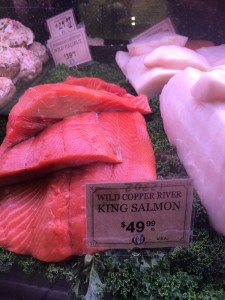The FDA today approved the sale of a farm-raised salmon that has been genetically modified.
The salmon has been modified with two genes that enable it to grow larger, and withstand cold waters. The genes used to modify the salmon came from a different species of salmon. In this case the Atlantic salmon is modified with a gene from the King or Chinook salmon to allow it to grow larger.
The Atlantic salmon was developed by Maynard, Mass.-based AquaBounty Technologies, a unit of Intrexon Corp. Some conservation groups note that Aquabounty was fined $9500 by the country of Panama for administrative issues. None of the issues raised by Panama had to do with fish escaping into the wild, the health of the fish, or the operations of the plant.
What if This Salmon Escapes?
The concern is that if this salmon escapes it might have a selective advantage over other salmon. That these salmon could out-compete native salmon for resources.
The salmon is an Atlantic Salmon and is planned to be raised in a contained system inland away from any rivers or oceans. It will not be raised in or near an ocean or river where it can escape.
All the genetically modified salmon will be female salmon. When salmon spawn the male salmon ejaculate into the rivers providing genetic material over a wide number of eggs. These female salmon will not be able to do that. If the female salmon escapes it is likely it will be infertile (over 98% are).
The gene that modifies the salmon is a gene commonly found in King salmon, which allow the Atlantic salmon to grow to a larger size. Thus, it is coding from proteins that humans commonly consume.
Two other obvious questions: king salmon share a similar biologic niche with silver salmon (a cousin of Atlantic salmon) – and yet have not been an issue.
Salmon overall, as a species, have declined, with the only renewable wild salmon coming from Alaska.
GMO in the Food Supply
It is estimated that over 75% of all processed food in the United States have been genetically modified. Most of those are grains – soy beans, corn, and cotton. This year the FDA approved genetically modified apples and potatoes.
It will take some time before these salmon are available in the market place.
The ability to modify genes in food has been made easier by the genetic editing system such as CRISPR that allows editing of the genome of the animal without inserting other genes. The technology for this is inexpensive.
Other genetically modified animals on the horizon have included pigs resistant to swine fever, pigs that pollute less, and goats that have more muscle and longer hair.
While the safety of consuming this salmon has not been in question – with the exception of some radical groups that worry about all GMO. The real question is: no one has put it to the taste test as of yet.
Farmed Salmon
Over 90% of the salmon sold in the United States is farm raised. Wild salmon is sustainable, but only 25 million tons of salmon were sold from Alaska, which is not enough to supply consumer demand. The issues about farm salmon were addressed in my blog Salmon: Wild versus Farmed.
Wild Alaskan Salmon

There is nothing like the beauty of Alaska, fishing quietly – if you think you know Zen you don’t til you are here
Growing up in Ketchikan, Alaska – the salmon capital of the world, I have a fondness for great fresh salmon: both catching it and eating it. Every year, with great ceremony, Alaska Airlines brings to Seattle the first Copper River King Salmon. It is seasonal, and delicious.
Previously wild salmon had higher levels of omega-3 fatty acids, however a change in the diet of farm salmon has altered that.
Whether the country will be interested in the marketing of a genetically modified, farmed salmon is still an open question. Salmon, in any form – is delicious. Some stores have stated they will not offer genetically modified salmon – which is a stand that has no merit.
In terms of consuming the salmon – I am certainly not worried about it. Larger salmon that might be less expensive- sounds potentially delicious.



